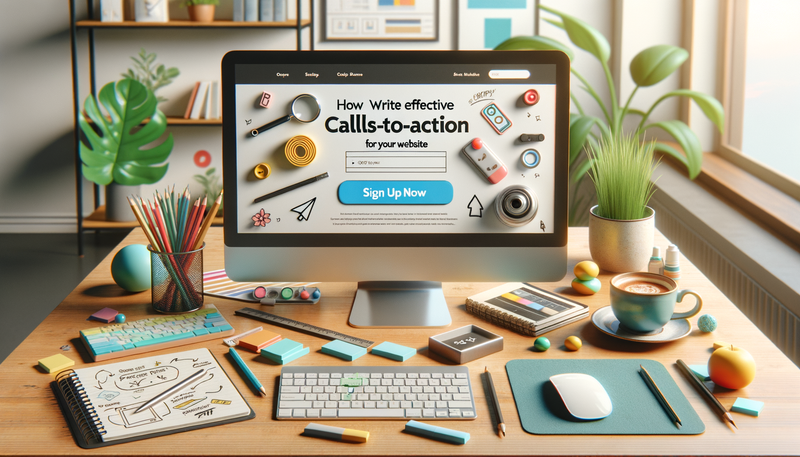How to Write Effective Calls-to-Action (CTAs) for Your Website
Crafting effective calls-to-action (CTAs) is a crucial skill for any website owner looking to boost user engagement and drive conversions. This comprehensive guide delves into the art of creating compelling CTAs that captivate visitors and motivate them to take desired actions. From mastering copywriting techniques to implementing strategic placement and design best practices, you'll learn how to optimize your website's performance through powerful CTAs. Whether you're a seasoned marketer or a beginner, this article will equip you with the knowledge and tools to create CTAs that resonate with your audience and achieve your business goals. Get ready to transform your website's conversion rates and user experience with expert CTA strategies.Table of Contents:

Understanding the Importance of CTAs
Calls-to-action are the driving force behind user engagement on your website. They serve as clear signposts, guiding visitors towards specific actions you want them to take. Whether it's signing up for a newsletter, making a purchase, or downloading a resource, well-crafted CTAs can significantly impact your conversion rates.Effective CTAs not only encourage immediate action but also help in moving potential customers through your sales funnel. By strategically placing and designing CTAs, you can create a seamless user journey that naturally leads to conversions. Remember, a strong CTA can be the difference between a visitor simply browsing your site and becoming a valuable lead or customer.
Do you need a website? Want to build a website but don't know where to start? Our website builder is the perfect solution. Easy to use, and with the ability to customize to fit your business needs, you can have a professional website in no time.
Crafting Compelling CTA Copy
The words you choose for your CTA can make or break its effectiveness. Start by using action-oriented verbs that inspire immediate response, such as 'Get,' 'Start,' 'Discover,' or 'Join.' These power words create a sense of urgency and excitement.Keep your CTA copy concise and clear, typically between 2-5 words. Clarity is key - your visitors should instantly understand what will happen when they click. Incorporate benefit-driven language that highlights the value proposition for the user. For example, instead of 'Subscribe,' try 'Get Free Tips.'
Personalization can also boost CTA effectiveness. Use first-person pronouns like 'my' or 'me' to make the action feel more personal. For instance, 'Start My Free Trial' can be more engaging than 'Start Your Free Trial.'
Strategic CTA Placement
The placement of your CTAs plays a crucial role in their effectiveness. While there's no one-size-fits-all approach, certain strategies can help optimize your CTA placement. Firstly, ensure your primary CTA is visible above the fold - the area of the webpage visible without scrolling. This immediate visibility can capture attention right away.For longer pages, consider using multiple CTAs strategically placed throughout the content. This allows you to capture interest at different stages of the user's journey through your page. However, be careful not to overwhelm your visitors with too many CTAs.
Another effective strategy is to place CTAs at natural decision-making points. For example, after explaining a product's benefits or at the end of a compelling piece of content. Always ensure your CTAs stand out from the surrounding elements to draw attention.
Building a website with SITE123 is easy
Designing Eye-Catching CTAs
The visual design of your CTA can significantly impact its performance. Start by using contrasting colors that make your CTA button stand out from the rest of your page. The color should be attention-grabbing but still align with your overall brand aesthetics.Size matters when it comes to CTAs. Make your buttons large enough to be easily clickable, especially on mobile devices. However, avoid making them so large that they overwhelm other important content on the page.
White space around your CTA can help it stand out and make it more visually appealing. Consider using subtle animations or hover effects to make your CTA more interactive and engaging. Remember, the goal is to make your CTA visually distinct and inviting without being intrusive or annoying.
A/B Testing Your CTAs
To truly optimize your CTAs, it's crucial to implement A/B testing. This involves creating two versions of a CTA and comparing their performance to see which one drives better results. You can test various elements such as copy, color, size, placement, and design.Start by identifying your key metrics, such as click-through rates or conversion rates. Then, create two versions of your CTA, changing only one element at a time. Run the test for a statistically significant period and analyze the results.
Remember that what works for one website or audience may not work for another. Continuous testing and optimization are key to finding the most effective CTAs for your specific audience and goals. Don't be afraid to experiment with different approaches and learn from the data you gather.
Mobile Optimization for CTAs
With the increasing prevalence of mobile browsing, optimizing your CTAs for mobile devices is crucial. Ensure your CTAs are easily tappable on smaller screens by making them large enough and providing enough space around them to prevent accidental clicks.Consider the placement of your CTAs on mobile devices. They should be easily accessible without requiring extensive scrolling. You might need to adjust the layout or create mobile-specific CTAs to ensure optimal performance across all devices.
Keep in mind that mobile users often have different intentions and behaviors compared to desktop users. Tailor your CTA copy and design to cater to these differences. For example, you might use 'Call Now' CTAs for mobile users looking for quick contact options.





